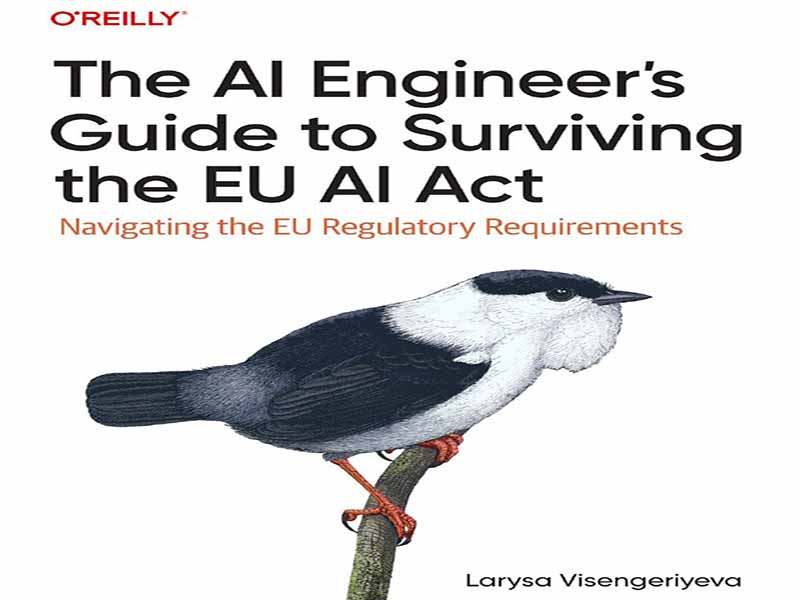- عنوان کتاب: The AI Engineer’s Guide to Surviving the EU AI Act
- نویسنده: Larysa Visengeriyeva
- حوزه: قانون هوش مصنوعی
- سال انتشار: 2025
- تعداد صفحه: 593
- زبان اصلی: انگلیسی
- نوع فایل: pdf
- حجم فایل: 6.48 مگابایت
قانون هوش مصنوعی اتحادیه اروپا که در آگوست 2024 به طور کامل لازمالاجرا شد، نقطه عطفی در تنظیم مقررات جهانی هوش مصنوعی است. به عنوان اولین چارچوب قانونی جامع برای هوش مصنوعی، هدف اعلام شده آن واضح است: تقویت نوآوری و توسعه در اتحادیه اروپا و در عین حال کاهش مؤثر خطرات احتمالی ناشی از سیستمهای هوش مصنوعی. این آییننامه بلندپروازانه، یک چارچوب قانونی یکنواخت حاکم بر توسعه، قرارگیری در بازار، راهاندازی و استفاده از سیستمهای هوش مصنوعی در سراسر اتحادیه اروپا ایجاد میکند. پیمایش پیچیدگیهای قانون هوش مصنوعی اتحادیه اروپا، در نگاه اول، ممکن است کاری منحصراً برای تیمهای حقوقی و کارشناسان سیاستگذاری به نظر برسد. این قانون در واقع پیچیده است و شامل 113 ماده است که به مسائل بسیار فنی میپردازند، که با 13 ضمیمه که جزئیات پیادهسازی را شرح میدهند و 180 رسیتال (جملههای مقدماتی که زمینه و راهنمایی برای تفسیر را ارائه میدهند) تکمیل میشود. با این حال، همانطور که الزامات عملی قانون هوش مصنوعی اتحادیه اروپا نشان میدهد، دستیابی و حفظ انطباق با قانون اساساً یک مشکل مهندسی است. این پیام اصلی این کتاب است. عملیاتی کردن انطباق با قانون هوش مصنوعی اتحادیه اروپا فراتر از تفسیر قانونی است. این امر مستلزم ایجاد نقشها، فرآیندها، ساختارها و شیوههای مهندسی هوش مصنوعی است. به عنوان مثال، انطباق پس از فروش، مستقیماً مستلزم اجرای شیوههای عملیات یادگیری ماشین (MLops) مانند نظارت و هشدار است. دستیابی موفقیتآمیز به انطباق با قانون هوش مصنوعی اتحادیه اروپا با درک طراحی، توسعه و نگهداری سیستمهای هوش مصنوعی مرتبط است. انطباق یک مهر قانونی نیست که در پایان چرخه عمر توسعه اعمال شود، بلکه یک فرآیند مداوم است که باید از ابتدا در هسته سیستمهای هوش مصنوعی مهندسی شود. اساس این قانون بر اساس مفهوم “هوش مصنوعی قابل اعتماد” است که سیستمها را در کل چرخه عمر خود قانونی، اخلاقی و قوی میکند. این امر مستلزم گنجاندن جنبههای اخلاقی و انطباق به طور مستقیم در فرآیند توسعه سیستم هوش مصنوعی است. این کتاب به عنوان راهنمای شما برای مقابله با انطباق با قانون هوش مصنوعی اتحادیه اروپا به عنوان یک چالش مهندسی عمل میکند. ما روشها و چارچوبهای عملی مختلفی را که برای این کار ضروری هستند، بررسی خواهیم کرد، از جمله: مهندسی هوش مصنوعی: به عنوان کاربرد اصول مهندسی نرمافزار در چرخه عمر سیستمهای هوش مصنوعی از ابتدا تا انتها – از جمله طراحی، توسعه، استقرار و نگهداری – تعریف میشود. CRISP-ML(Q) این فرآیند توسعه ساختاریافته یادگیری ماشین، طرحی برای طراحی، توسعه و نگهداری سیستمهای هوش مصنوعی با در نظر گرفتن انطباق با قوانین ارائه میدهد. تأکید آن بر تضمین کیفیت و مدیریت ریسک مداوم در طول چرخه حیات هوش مصنوعی، مستقیماً با رویکرد مبتنی بر ریسک قانون هوش مصنوعی اتحادیه اروپا همسو است. CRISP-ML(Q) مستلزم مستندسازی کل فرآیند توسعه، از جمله اقدامات مدیریت ریسک است که برای برآورده کردن الزامات مستندسازی فنی و شفافیت قانون بسیار مهم است.
The European Union’s Artificial Intelligence Act, which came into full effect in August 2024, represents a watershed moment in the global regulation of artificial intelligence. As the first comprehensive legal framework for AI, its stated purpose is clear: to foster innovation and development within the EU while effectively mitigating the potential risks posed by AI systems. This ambitious regulation establishes a uniform legal framework governing the development, placement on the market, putting into service, and use of AI systems across the EU. Navigating the complexities of the EU AI Act might, at first glance, seem like a task exclusively for legal teams and policy experts. The Act is indeed complex, featuring 113 articles that address highly technical issues, complemented by 13 annexes that detail implementation specifics and 180 recitals (introductory statements providing context and guidance for interpretation). However, as the practical requirements of the EU AI Act reveal, achieving and maintaining compliance with the Act is fundamentally an engineering problem. This is the core message of this book. Operationalizing EU AI Act compliance goes far beyond legal interpretation. It requires establishing roles, processes, structures, and AI engineering practices. Postmarket compliance, for instance, directly necessitates the implementation of machine learning operations (MLOps) practices such as monitoring and alerting. Successfully achieving EU AI Act compliance is linked to understanding the design, development, and maintenance of AI systems. Compliance is not a legal stamp applied at the end of the development lifecycle, but a continuous process that must be engineered into the core of AI systems from the beginning. The Act’s foundation on the concept of “trustworthy AI” mandates that systems be lawful, ethical, and robust throughout their entire lifecycle. This necessitates embedding ethical and compliance aspects directly into the AI system development process. This book serves as your guide to tackling EU AI Act compliance as the engineering challenge it is. We’ll explore various practical methodologies and frameworks essential for this task, including: AI engineering Defined as the application of software engineering principles to the end-to-end lifecycle of AI systems— including design, development, deployment, and maintenance. CRISP-ML(Q) This structured machine learning development process provides a blueprint for designing, developing, and maintaining AI systems with compliance in mind. Its emphasis on quality assurance and continuous risk management throughout the AI lifecycle is directly aligned with the EU AI Act’s risk-based approach. CRISP-ML(Q) requires documentation of the entire development process, including risk management measures, which is crucial for meeting the Act’s technical documentation and transparency obligations.
این کتاب را میتوانید از لینک زیر بصورت رایگان دانلود کنید:
Download: The AI Engineer’s Guide to Surviving the EU AI Act



































نظرات کاربران